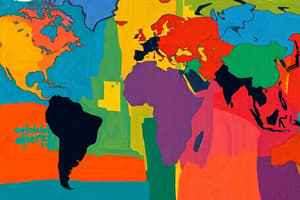Podcast
Questions and Answers
What fraction of the world’s population had incomes below $1 per day in 1970?
What fraction of the world’s population had incomes below $1 per day in 1970?
- 40%
- 20% (correct)
- 10%
- 30%
What was the percentage of the world’s population living below the $1 poverty line in 2000?
What was the percentage of the world’s population living below the $1 poverty line in 2000?
- 5%
- 15%
- 10%
- 7% (correct)
How did income distribution change from 1970 to 2000?
How did income distribution change from 1970 to 2000?
- It shifted to the right. (correct)
- It fluctuated significantly.
- It shifted to the left.
- It remained unchanged.
What effect did inequality within large countries have on global inequality from 1970 to 2000?
What effect did inequality within large countries have on global inequality from 1970 to 2000?
What trend occurred in the dispersion of average income across countries from 1970 to 2000?
What trend occurred in the dispersion of average income across countries from 1970 to 2000?
Which sectors typically grow in contribution to GDP as an economy develops over time?
Which sectors typically grow in contribution to GDP as an economy develops over time?
Which of the following is NOT included in GDP calculations?
Which of the following is NOT included in GDP calculations?
What is the main argument of the neoclassical counterrevolution regarding underdevelopment?
What is the main argument of the neoclassical counterrevolution regarding underdevelopment?
Which approach emphasizes the self-interested behavior of public officials?
Which approach emphasizes the self-interested behavior of public officials?
What do neoliberals argue will be stimulated by eliminating government regulations?
What do neoliberals argue will be stimulated by eliminating government regulations?
Which of the following is a characteristic of the market-friendly approach?
Which of the following is a characteristic of the market-friendly approach?
According to the neoclassical counterrevolution, what is a significant barrier to development in the Third World?
According to the neoclassical counterrevolution, what is a significant barrier to development in the Third World?
What is the basic premise of the Harrod-Domar model?
What is the basic premise of the Harrod-Domar model?
What does the equation Y(t) = C(t) + S(t) represent?
What does the equation Y(t) = C(t) + S(t) represent?
What role does the capital-output ratio, θ, play in the Harrod-Domar equation?
What role does the capital-output ratio, θ, play in the Harrod-Domar equation?
What factor does the augmented Harrod-Domar equation include to account for growth?
What factor does the augmented Harrod-Domar equation include to account for growth?
How does the saving rate typically change as a country develops from low to middle income?
How does the saving rate typically change as a country develops from low to middle income?
During the demographic transition, what happens to the birth and death rates as a country's GDP increases?
During the demographic transition, what happens to the birth and death rates as a country's GDP increases?
According to the Harrod-Domar model, what is one possible source of growth?
According to the Harrod-Domar model, what is one possible source of growth?
What does the equation S(t) = I(t) signify in the context of the model?
What does the equation S(t) = I(t) signify in the context of the model?
What happens to the population growth rate with further development after an initial increase?
What happens to the population growth rate with further development after an initial increase?
What is considered necessary for economic growth besides increased savings and investment?
What is considered necessary for economic growth besides increased savings and investment?
Which of the following is NOT a characteristic feature of economic development?
Which of the following is NOT a characteristic feature of economic development?
What is a key factor that distinguishes differences in development among countries?
What is a key factor that distinguishes differences in development among countries?
Which of the following describes the focus of structural-change analysts?
Which of the following describes the focus of structural-change analysts?
Which of the following changes is associated with socioeconomic factors in economic development?
Which of the following changes is associated with socioeconomic factors in economic development?
The International-Dependence Revolution emerged due to what perceived failure?
The International-Dependence Revolution emerged due to what perceived failure?
What major transition occurs as countries develop economically?
What major transition occurs as countries develop economically?
What is a demographic trend observed during economic development?
What is a demographic trend observed during economic development?
What aspect of economic development includes changes in international trade?
What aspect of economic development includes changes in international trade?
Which factor is essential for the transition to a modern economic system?
Which factor is essential for the transition to a modern economic system?
What does profit represent in the context of production?
What does profit represent in the context of production?
Which of the following factors is considered crucial for industrialization in the modern sector?
Which of the following factors is considered crucial for industrialization in the modern sector?
What is one implication of low wages in the industrial sector?
What is one implication of low wages in the industrial sector?
Which criticism of the Lewis Model suggests that labor transfer may not keep pace with capital accumulation?
Which criticism of the Lewis Model suggests that labor transfer may not keep pace with capital accumulation?
What phenomenon describes economic growth that does not lead to a rise in employment?
What phenomenon describes economic growth that does not lead to a rise in employment?
What does Chenery's findings illustrate in the context of development?
What does Chenery's findings illustrate in the context of development?
What is the main focus of patterns-of-development analysis of structural change?
What is the main focus of patterns-of-development analysis of structural change?
What impact can low wages have on rural areas?
What impact can low wages have on rural areas?
Which of the following statements about urban unemployment is accurate?
Which of the following statements about urban unemployment is accurate?
What is a key limitation mentioned regarding the relationship between capital accumulation and labor employment?
What is a key limitation mentioned regarding the relationship between capital accumulation and labor employment?
Flashcards
Income Distribution Shift
Income Distribution Shift
The shift in income distribution towards higher income levels over time, leading to a decrease in the proportion of people living below the poverty line.
Economic Development
Economic Development
The economic growth that occurs with a shift towards more advanced industries like manufacturing and services, replacing agriculture as the dominant sector.
Underground Economy
Underground Economy
The economic activity performed outside of official records, like informal markets or unreported trades.
Volunteer Work
Volunteer Work
Signup and view all the flashcards
Income Inequality Across Countries
Income Inequality Across Countries
Signup and view all the flashcards
Income Inequality Within Countries
Income Inequality Within Countries
Signup and view all the flashcards
GDP (Gross Domestic Product)
GDP (Gross Domestic Product)
Signup and view all the flashcards
Harrod-Domar Model
Harrod-Domar Model
Signup and view all the flashcards
Equation 1: Y(t) = C(t) + S(t)
Equation 1: Y(t) = C(t) + S(t)
Signup and view all the flashcards
Equation 2: Y(t) = C(t) + I(t)
Equation 2: Y(t) = C(t) + I(t)
Signup and view all the flashcards
Equation 3: S(t) = I(t)
Equation 3: S(t) = I(t)
Signup and view all the flashcards
Equation 4: K(t+1) = (1-δ)K(t) + I(t)
Equation 4: K(t+1) = (1-δ)K(t) + I(t)
Signup and view all the flashcards
Equation 5: S(t)/Y(t) = s
Equation 5: S(t)/Y(t) = s
Signup and view all the flashcards
Equation 6: K(t)/Y(t) = θ
Equation 6: K(t)/Y(t) = θ
Signup and view all the flashcards
Harrod-Domar Equation: s/θ = g+δ
Harrod-Domar Equation: s/θ = g+δ
Signup and view all the flashcards
Harrod-Domar Model with Population Growth: s/θ = g*+n+δ
Harrod-Domar Model with Population Growth: s/θ = g*+n+δ
Signup and view all the flashcards
Profit in the Manufacturing Sector
Profit in the Manufacturing Sector
Signup and view all the flashcards
No Capital Flight in the Lewis Model
No Capital Flight in the Lewis Model
Signup and view all the flashcards
Impact of Low Wages in the Lewis Model
Impact of Low Wages in the Lewis Model
Signup and view all the flashcards
Consequences of Industry Expansion in the Lewis Model
Consequences of Industry Expansion in the Lewis Model
Signup and view all the flashcards
Criticism of the Lewis Model: Unequal Rate of Transfer
Criticism of the Lewis Model: Unequal Rate of Transfer
Signup and view all the flashcards
Criticism of the Lewis Model: Surplus Labor?
Criticism of the Lewis Model: Surplus Labor?
Signup and view all the flashcards
Criticism of the Lewis Model: Institutional Factors
Criticism of the Lewis Model: Institutional Factors
Signup and view all the flashcards
Criticism of the Lewis Model: Diminishing Returns
Criticism of the Lewis Model: Diminishing Returns
Signup and view all the flashcards
Limitation of the Lewis Model: Labor Transfer and Urban Unemployment
Limitation of the Lewis Model: Labor Transfer and Urban Unemployment
Signup and view all the flashcards
Limitation of the Lewis Model: Profit Reinvestment
Limitation of the Lewis Model: Profit Reinvestment
Signup and view all the flashcards
Neoclassical Counterrevolution
Neoclassical Counterrevolution
Signup and view all the flashcards
Free Market Approach
Free Market Approach
Signup and view all the flashcards
Public Choice Approach
Public Choice Approach
Signup and view all the flashcards
Market-Friendly Approach
Market-Friendly Approach
Signup and view all the flashcards
Traditional Neoclassical Growth Theory
Traditional Neoclassical Growth Theory
Signup and view all the flashcards
Structural Changes in Economic Development
Structural Changes in Economic Development
Signup and view all the flashcards
Urbanization in Economic Development
Urbanization in Economic Development
Signup and view all the flashcards
Accumulation of Capital
Accumulation of Capital
Signup and view all the flashcards
Domestic Constraints in Development
Domestic Constraints in Development
Signup and view all the flashcards
International Constraints in Development
International Constraints in Development
Signup and view all the flashcards
The 'Correct Mix' of Economic Policies
The 'Correct Mix' of Economic Policies
Signup and view all the flashcards
Decline in Family Size
Decline in Family Size
Signup and view all the flashcards
Demographic Transition
Demographic Transition
Signup and view all the flashcards
Sequential Process of Development
Sequential Process of Development
Signup and view all the flashcards
The International-Dependence Revolution
The International-Dependence Revolution
Signup and view all the flashcards
Study Notes
Economic Development
- Economic development is a multifaceted process, encompassing improvements in living standards, reduction of inequality, and expansion of opportunities.
- It involves a complex interplay of economic, social, political, and institutional factors.
- Different theories and models offer various perspectives on the factors driving and shaping it.
Rural-Urban Migration
- Urban populations are growing faster than rural populations globally.
- The majority of the world's population currently lives in cities.
- Factors influencing rural-urban migration include economic opportunities, higher wages, and better living conditions in urban areas.
Incomes and Growth Around the World
- Income inequality is substantial globally.
- Growth rates vary significantly across countries, with some countries experiencing rapid growth while others remain stagnant.
- Both rich and poor countries can experience changes in their income levels over time.
Methodological Approach
- Economic development studies utilize various approaches and theories, along with case studies.
- Different frameworks, such as the international dependence model versus the market failure and government intervention approach, shape analysis and focus areas.
Nature of Development Economics
- Development economics broadly considers the efficient allocation of resources and optimal growth of resources over time to produce an ever-expanding range of goods and services, going beyond elementary neoclassical economics.
- It encompasses social and institutional processes through which economic and political elites influence resource allocation.
- Development economics has a broader scope, addressing the economic, social, political, and institutional mechanisms necessary to achieve improvements in living standards for people across diverse regions.
Non-economic Factors
- Values, attitudes, and institutions are crucial elements influencing the overall development process.
- Development is a multidimensional process.
- It requires changes to structures, popular attitudes, national institutions and eradicating poverty.
Economic Growth and Development
- Economic growth often leads to a reduction in poverty in many countries.
- There is a relationship between income and poverty rates.
- Some models show that inequality may increase initially with economic growth but may decrease later.
Measuring Development
- GDP per capita is a widely used measure, but it has limitations as a comprehensive measure of development as it doesn't consider income distribution.
- Purchasing power parity (PPP) factors are incorporated in various measures of economic development to correct for the different purchasing power of currency in a country.
- The Human Development Index (HDI) considers multiple aspects of development, including income, health, and education.
Development Theories: Stages of Growth, Structural Change, and Dependence
- The linear-stages model of development suggests that countries follow a series of chronological phases in their economic growth process, with developed countries as guides.
- The structural-change model focuses on the transformation from a primarily agricultural economy to one dominated by manufacturing and service industries.
- The international dependence approach, often critical of previous models, emphasizes the role of external factors and global power imbalances in shaping economic development.
Neoclassical Counter-Revolution
- Neoclassical economists generally favor market-driven approaches to development, emphasizing the efficiency of market mechanisms and minimizing government intervention.
- This school of thought challenges the earlier emphasis on government intervention.
- This approach is usually viewed as a rebuttal to the interventionist approach of the previous models/theories.
Development as Growth & Linear-Stages Theories
- Capital is understood as the binding constraint.
- Development is closely linked to investment and capital accumulation.
Development as a Social Process
- Development is a multifaceted social process, encompassing economic factors, social structures and institutions.
- Historical trajectories and political contexts heavily influence development outcomes.
Theories of Economic Growth and Development
- The theories of economic growth and development evolved during the post-World War II era, with both developed world and less developed country scholars contributing.
- Linear-stages, structural change, and international dependence theories each offered different perspectives.
Factors of Development (Economic)
- Savings and investments are crucial to economic growth.
- Production factors, such as the availability of labor, land, capital, and resources influence growth rates.
- Productivity levels, technology advancements and efficiency improvements influence economic growth.
The Production Function (of Growth)
- Economic models use functions explaining the relationships between input and output.
- These are used to explain how variables, such as labor and capital, relate to outputs like production output.
The O-ring Theory
- Kremer’s O-ring model stresses the importance of complementarities and matching of skills among workers in production.
- The model explains how skill differences affect the productivity of groups of workers, showing that efficient matching is essential for high output and that variations in individual skills significantly impact overall productivity.
- This model emphasizes how specialization and the efficiency/inefficiency of skill combination can lead to varying outcomes in different economies.
The Big Push Model
- The Big Push model suggests the need for a large-scale investment to overcome coordination failures and stimulate economic growth.
Poverty Traps
- Poverty traps describe how poverty can perpetuate itself due to various economic, social, or psychological factors.
- Models explain various types of traps.
- Poverty traps, often linked to multiple equilibria, hinder development progress, emphasizing the importance of policies that improve conditions of existing systems.
Population Growth
- Rapid population growth can hinder development, leading to strained resources and reduced living standards.
- Population growth is related to various indicators of development.
- Population is not the primary issue driving underdevelopment. Other factors, including issues inherent in institutions and policy, play more critical roles in development outcomes.
- Policies for population control have been controversial and often poorly received/rejected in developing countries.
Urbanization and Development
- Urbanization is a significant shift in population distribution to cities.
- Cities offer economic and social opportunities, potentially spurring growth, but also have various issues that can hinder or slow growth.
- Development strategies often fail to address the specific issues relevant to urban growth, so strategies to improve development in cities are specific and need their own policy considerations.
Traditional and Modern Sectors
- Development models often distinguish between traditional (agricultural) and modern (industrial) sectors in economies.
- Transformation from agriculture to industry is a common process in developing countries.
Economic Growth and Development Models
- Many models are used to explain the economic growth of a country.
- Various theories try to analyze the connection between economic growth rate and inequality.
- These theories can have strong assumptions, so the theories need to be seen within that framework.
Studying That Suits You
Use AI to generate personalized quizzes and flashcards to suit your learning preferences.
Related Documents
Description
Test your knowledge on global income distribution changes from 1970 to 2000. This quiz explores various aspects of poverty, GDP, and economic theories related to development. Understand the impact of inequality and the evolution of economic sectors over time.




